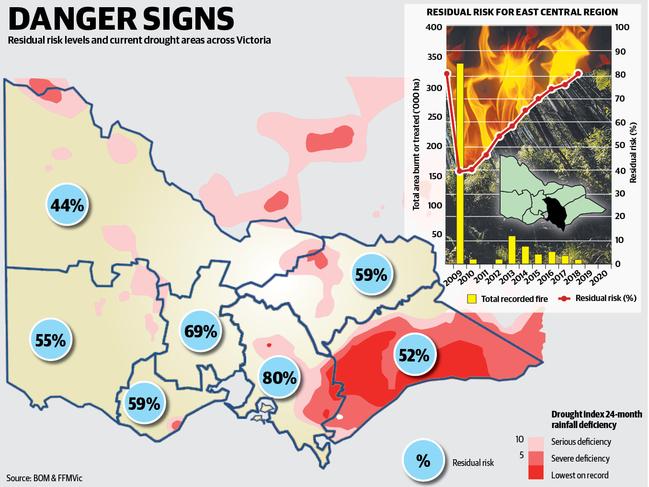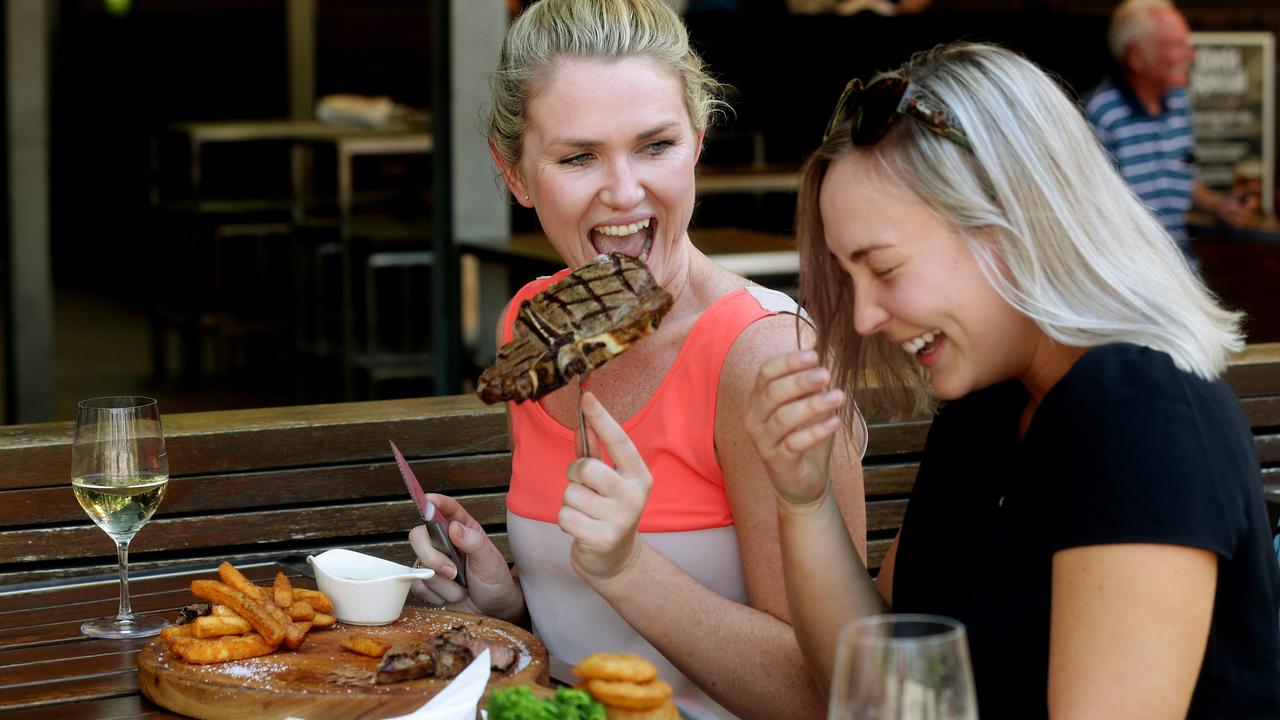Victorian bushfire risk back to Black Saturday levels with fuel reduction applied to just 8048ha
THE bushfire risk is back to Black Saturday levels in Victoria’s most dangerous and populous zone, stretching from Kilmore to Morwell and covering 59 per cent of the state’s population.

THE bushfire risk is back to Black Saturday levels in Victoria’s most dangerous and populous zone, stretching from Kilmore to Morwell and covering 59 per cent of the state’s population.
The residual risk in Victoria’s East Central zone has climbed from 39 per cent in the aftermath of Black Saturday’s fire storms to 80 per cent today — the same level it reached just before February 7, 2009.
Drought has exacerbated the situation, with much of the zone facing severe rainfall deficiencies.
Dense regrowth, fallen timber and standing dead trees have led to warnings fuel loads in areas burnt out in the 2009 firestorms could be even higher than prior to Black Saturday.
EDITORIAL: BLACK SATURDAY LESSONS IGNORED
But Forest Fire Management Victoria refuses to release crucial information, telling The Weekly Times “fuel load data is only published to Business Level Data (an internal system), which means it is only available to internal DELWP users”.
The only information publicly available is Victoria’s latest fuel management report, which shows FFMVic applied controlled burns or mechanical treatment to just 8048ha of the East Central zone’s 2.3 million hectares in 2017-18.
The Victorian Government's policy states it aims to “maintain residual risk at or below 70 per cent”. Yet Environment Minister Lily D’Ambrosio told The Weekly Times “we are below the statewide residual risk targets we have set”.
FITNESS TEST EXODUS WARNING TO CFA
Ms D’Ambrosio refused to answer questions on whether a residual risk of 80 per cent was acceptable in Victoria’s most populous bushfire zone. Across the state, the FFMVic’s 2017-18 report shows it spent $107.8 million to burn or treat 74,825ha, at a cost of $1421/ha, a huge rise on previously reported costs of $30-$300/ha in 2003.
The treated area is a fraction of the 390,000ha annual fuel reduction target set by the 2009 Victorian Bushfire Royal Commission, which called on the State Government to treat a “5 per cent minimum of public land”.
The Royal Commission was scathing in its criticism of the former Bracks Labor Government’s Department of Sustainability and Environment for only setting a target of 130,000ha in the lead-up to Black Saturday.
Yet the Andrews Government abandoned hectare-based targets in 2015, opting for a computer modelled measure of residual risk — the simulated difference between impacts of a fire with maximum fuel loads versus one with reduced fuel loads resulting from controlled burns and past wildfires.
One of Australia’s leading bushfire scientists, Phil Cheney said residual risk was a “load of bulls---”. As the former head of CSIRO’s bushfire research unit, Dr Cheney said residual risk was a measure developed “by people with no on-ground experience” running computer algorithms they “think are true”. “If you look at risk, what you can control, fuel load is the only thing that matters,” he said. Dr Cheney said numerous investigations had called for greater effort and resources being put into fuel reduction burns. Those include:
The 1939 Bushfires Royal Commission: “Justice Stretton said the amount of prescribed burning done by the then Forests Commission was ‘ridiculously inadequate’ because of a staff shortage and a tardy recognition of the importance of preventive measures”.
The 2002-03 Victorian Bushfires inquiry calling for an annual optimum area for prescribed burning and routine public reporting of areas treated.
The 2008 Environment and Natural Resources Committee reporting: “A minimum average of 5 per cent of the public land estate, comprising 7.7 million hectares, should be adopted as the annual prescribed burning target by DSE”.
The 2009 Royal Commission stating it was: “concerned that the State has maintained a minimalist approach to prescribed burning despite a number of recent official or independent reports and inquiries, all of which have recommended increasing the prescribed burning program”.
Former Forests NSW chief silverculturist and author of Firestick Ecology Vic Jurskis said the biggest concern was that fuel loads were now higher than they were prior to Black Saturday. “Fuel (loads) increase much faster after a high intensity fire,” Mr Jurskis said. “It turns green fuels into dry fuel, more litter and fallen timber and you end up with a solid wall of three-dimensional fuel.”
In a prophetic warning, the 2009 Royal Commission’s final report warned: “The State has allowed the forests to continue accumulating excessive fuel loads. “Not dealing with this problem on a long-term and programmed basis means that fuel levels continue to increase, adding to the intensity of bushfires that inevitably eventuate and placing firefighters and communities at greater future risk.”


